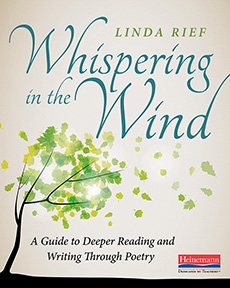A Poetry Resource Sure to Engage Students
Whispering in the Wind: A Guide to Deeper Reading and Writing Through Poetry
By Linda Rief
(Heinemann, 2022 – Learn more)
Reviewed by Kasey Short

Poetry is one of my favorite things to teach because of the emotional response it inspires and the connections it fosters. Linda Rief’s book offers practical advice, concrete examples, and specific resources for expanding the teaching of reading and writing poetry by creating “Heart Books” in the tradition of Georgia Heard.
This book is a great resource for teachers with many ideas that can be adapted across grade levels. The details provided by the author supply everything needed to implement her ideas and will bolster the reader’s confidence.

Including this toward the beginning of the book helps readers picture how and when this could work in their classrooms, which is an essential element for any book written for teachers. If teachers can’t picture how to make it work for them from the beginning, they will often abandon a professional book, but it is evident that Linda Rief (who only recently retired from the middle school classroom) knows and understands her audience.
Helping students connect with poetry
If teachers are looking for ways to help students find a love of reading and writing poetry, this is the perfect book. “Heart Books” help students fall in love with poetry by helping them make connections to poems, giving them choice in what they read and how they interact with poems, and encouraging them to think about how the poems make them feel.
Making these deep, thoughtful connections to poetry instead of answering questions about poems is exactly what students need, and this book provides a roadmap for doing this in a classroom.
The layout and order of the book are logical and provide teachers everything they need to fully understand how to implement the concept. Each of her instructions and examples, including differentiation through choice of text and choice of demonstrating ideas, show that she meets kids where they are and pushes them to continue to grow.
Reif’s comprehensive and varied examples – showcasing what is possible when students engage in this project and these resources – make this book particularly helpful and show that there are many ways to be successful with this assignment.
It would be helpful for teachers who are in their first year of doing this project to show the book’s student examples to their own students as models to inspire their work. Rief also provides examples of poems and resources for gathering poems. Teachers who might be interested in the project but don’t know where to start with finding poetry have everything they need here to provide their students with a variety of diverse options.
Adding visual arts to the picture
The project also offers students a chance to show off their creativity and use visual arts skills to enhance their work. The opportunity of including visual arts will engage students and present interesting opportunities to collaborate with art teachers. For teachers who don’t have access to an art teacher and are not familiar with art techniques, Rief offers multiple examples with instructions for art that can be incorporated into the poetry study.
The appendix is filled with specific and extremely useful documents. Read them, use them in your classroom and share with art teachers. The book’s powerful afterword provides a lesson you can do in your classroom tomorrow and reinforces the importance and beauty of poetry.
For more ideas read Linda Rief’s 2022 MiddleWeb article, What Changes Kids’ Minds about Poetry?
Kasey Short (@shortisweet3) loves to share ideas from her classroom and writes frequently for MiddleWeb. She attended the University of North Carolina at Chapel Hill and earned a bachelor of arts in middle school education with a concentration in English and history. She went on to earn a master’s in curriculum and instruction from Winthrop University. Kasey is the Middle School Director of Studies and an 8th Grade English Teacher and Advisor at Charlotte (NC) Country Day School.


































